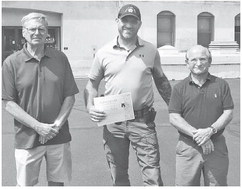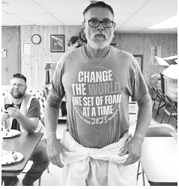Despite short career, Sharpe certainly worthy of Saturday’s induction


In more than 100 years of Green Bay Packers football, God only knows how many “what if” stories could be written. There are “what ifs” that could’ve meant the end of the franchise, “what ifs” that could’ve changed games, changed seasons, changed careers and added championships. Or, you might argue, some “what ifs” could’ve taken away championships.
Fans will be reminded of one of the biggest “what ifs” in Packers history when Sterling Sharpe finally gets his long overdue induction into the Pro Football Hall of Fame in Canton, Ohio on Saturday.
It’s really hard to believe it’s been almost 31 years since Sharpe last played in an NFL game. That game on Dec. 24, 1994 was just one of the many dominant performances he had as a Packer wide receiver, especially in his three seasons under head coach Mike Holmgren. He caught nine passes for 132 yards in three touchdowns that day in a 34-19 win at Tampa Bay that sealed the team’s second straight playoff berth and capped the team’s third straight 9-7 season that started Green Bay’s rise from the NFL dead.
The Packers beat Detroit 16-12 in a wild card game the following week –– the famous “we held Barry Sanders to minus-1 yards rushing” game –– but Sharpe did not suit up for that game and never did again due to a neck injury discovered after the Tampa game.
It was an absolute crime. While he had more catches in 1992 and 1993 with then-NFL records of 108 and 112 receptions, I would argue Sharpe was his most unstoppable in the second half of the 1994 season, just as Brett Favre was finally figuring out how to consistently play quarterback. Sharpe finished that year with 94 catches for 1,119 yards and an NFL-leading 18 touchdowns.
The 1994 season is one that, for whatever reason, is etched in my memory just as much as the two Super Bowl title seasons of my lifetime. I guess it was a meaningful fall for me while finishing my last semester of college and transitioning into a full-fledged adult. My theory, 31 years later, is I knew life was going to change soon and I wanted to soak in and remember as much as possible about that fall.
I can tell you where I was and who I was with for every Packers game of that season, whether it was in a dorm room, home in Medford, at Josie’s Bar by the hunting trailer in Finley or at Mel’s Midtowner in downtown River Falls, one of the few places in the city you could watch the Packers during the NFC’s first season on Fox when they and the ugly purple team just to the west were playing at the same time.
The start to 1994 was controversial. Sharpe walked out on the team the day before the season opener against the ugly purple team in a contract dispute. The sides worked their differences in the next 24 hours and Sharpe played, scoring the Packers’ only touchdown in a 16-10 win.
The offense struggled in the first half of the season and things reached a tipping point on Thursday, Oct. 20 when, as I watched from the upper deck of the Metrodome, Favre got hurt while throwing a pick-six in the first quarter of a defensive battle with Minnesota. The Packers’ defense was incredible. You’ve probably seen the video of Reggie White throwing Cris Carter halfway across the field when the Vikings foolishly had him try to block White. That was the game. But, with Mark Brunell struggling to lead the offense and fumbling a snap when the Packers had their one chance to put the game away, the defense wound up being on the field way too much and tired, leading to a gametying field goal at the end of regulation, a lost coin toss and a game-losing field goal in overtime, the Vikings’ only six offensive points in a 13-10 final that dropped Green Bay to 3-4.
The story is Holmgren was toying one last time after that game with the idea of benching Favre, tiring of his inconsistency. But he stuck with him and, well, we all know what happened after that. Favre took off and Sharpe took off as well, though it took him a couple more weeks.
After leaving a Nov. 13 game with the Jets early due to injury –– the first sign of trouble –– Sharpe scored twice in a loss to Buffalo and had a ridiculous game the entire nation saw in a 42-31 Thanksgiving Day loss to reigning two-time world champion Dallas. He caught nine passes for 122 yards and four touchdowns, one of which remains one of the most incredible throws and catches I’ve seen when Sharpe somehow got both feet down on a laser from Favre that carried to the very back of the end zone.
Sharpe had 10 catches for 115 yards and a score in a loss at Detroit, caught seven balls with two scores in a 40-3 blowout win over Chicago and, on my graduation day, had an early score in the win over Atlanta in the last game in Milwaukee. But he exited that game early –– the second sign of trouble. He was back that one last time at Tampa the following week.
Statistically, 1992 probably was Sharpe’s best year with 108 catches, a career-high 1,461 yards and 13 scores as Favre’s only real wide receiver threat. Who can forget the 1993 playoff game in Detroit where he scored three times, including the game-winner on a 40-yard bomb with 55 seconds left?
In that stretch, the list of the NFL’s top receivers started and ended with Jerry Rice and Sharpe. They played with two different styles. Rice was the graceful gazelle who ran perfect routes in San Francisco’s precision offense and then would outrun defenders. Sharpe wasn’t slow. He outran his share of defenders, but he won more with muscle, beating cornerbacks at the line of scrimmage, winning contested balls and then breaking tackles. He almost never practiced in those last couple years as he was constantly fighting injuries.
Just like that at age 29, Sharpe was gone after 595 catches, 8,134 yards, 65 touchdowns, three first-team All-Pro awards and five Pro Bowls. Those numbers average out to 85 catches, 1,162 yards and 9.3 touchdowns per year. He only caught 55 balls and had just one touchdown as a rookie. He jumped to 90 catches, 1,423 yards and 12 scores in year two, the 1989 Majik season where Don Majkowski became a folk hero.
The irony is Sharpe’s departure actually enhanced Favre’s growth as he was forced to start spreading the ball around rather than just looking for number 84. Maybe it worked out for the best. But what if Sharpe had been around another six or seven years? How would his numbers have stacked up against the all-time best? Would the Packers ever gotten Keith Jackson, Antonio Freeman or Donald Driver? Would he have a Super Bowl ring or two?
I never understood why it took Hall of Fame voters so long to give Sharpe his due. It seems ridiculous that Denver running back Terrell Davis could get inducted in 2017 after just seven seasons –– and just four full seasons –– and Sharpe was barely on the Hall of Fame radar for years. I guess Davis did have that one game against Green Bay in a Super Bowl. It’s great to see Sharpe’s numbers and impact have finally been appreciated.
A man of few words when he was a Packer, I’m anxious to hear Sharpe’s acceptance speech Saturday and hear what he has to say about those seven years in Green Bay. He played under some bad teams and with some bad quarterbacking at times. But he was a big reason the Packers turned things around in 1992 under Holmgren and his staff. Unfortunately, he wasn’t there when they reached the pinnacle in 1996.
He remains on my top-five list, maybe higher, of my favorite and most fascinating Packers to watch in the last 45 years.
Matt Frey is the Sports Editor at The Star News.


